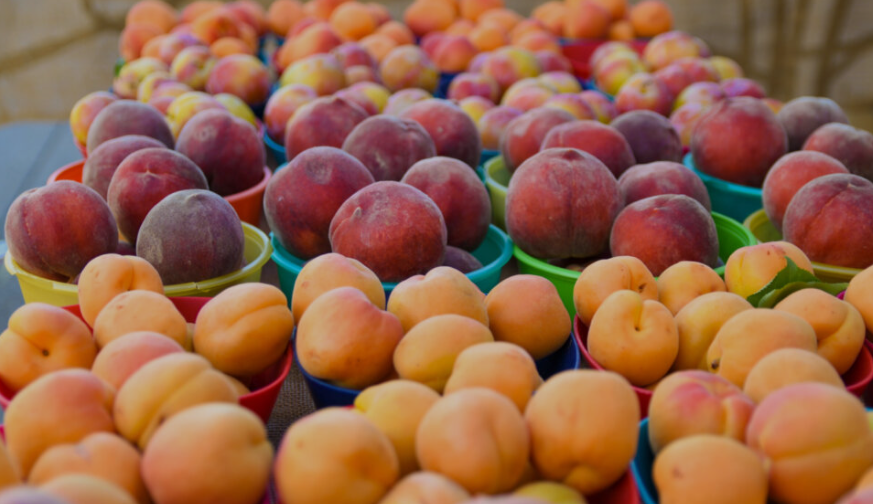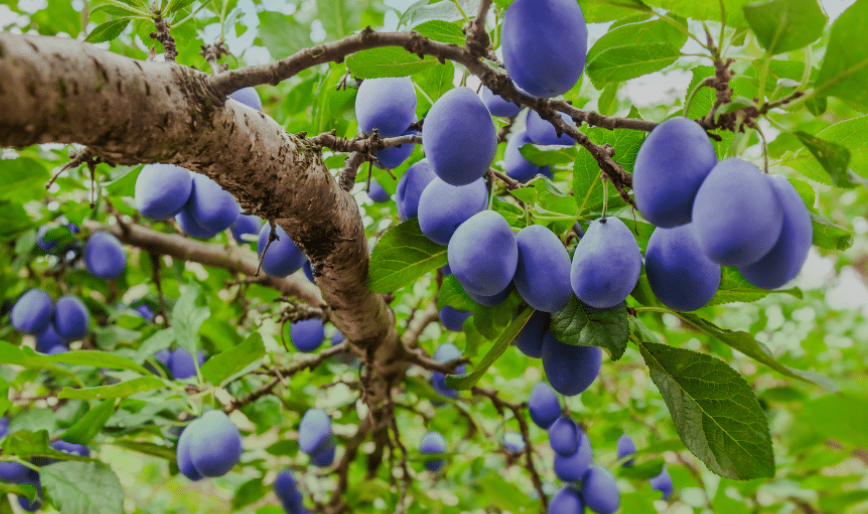
Stone fruits, also known as drupes, are a diverse group of fruits characterized by their fleshy exterior and a single hard stone or pit inside, which protects the seed. They come in many forms, from the familiar peaches, cherries, and plums to tropical varieties like mangoes and lychees. Despite their differences in taste, size, and appearance, they share the common botanical structure of having a tough inner shell surrounded by juicy, edible flesh. This unique structure makes them both appealing to humans and well-adapted for seed protection and dispersal in nature.
Most of these fruits are rich in vitamins A and C, dietary fiber, and antioxidants that help support immunity, digestion, and overall well-being. Their natural sugars make them a sweet but healthier alternative to processed snacks, while their low calorie content makes them suitable for weight-conscious diets. Many varieties, such as cherries and plums, contain phytochemicals linked to reducing inflammation and supporting heart health, highlighting their role as both delicious and functional foods.
Stone fruits can be eaten fresh, juiced, baked, or preserved in jams and chutneys. Some, like apricots and dates, are commonly dried for long-term storage and snacking. Others, such as olives and coconuts, are valued less for sweetness and more for their oils and savory applications. Their tangy, sweet, or aromatic flavors also make them popular in desserts, beverages, and even savory dishes where they balance rich or salty ingredients.
Stone fruits are cultivated across the globe, adapting to both temperate and tropical climates. In North America and Europe, peaches, cherries, and plums dominate orchards, while in Asia and Africa, mangoes, lychees, and dates have been central to agriculture and cuisine for centuries. Each region has its specialties, often tied to cultural traditions, festivals, and local dishes, showing how deeply embedded these fruits are in human history and lifestyles.
Stone fruits hold cultural and symbolic significance. For example, cherries are celebrated in Japan during spring blossom festivals, peaches are associated with longevity and good fortune in Chinese culture, and olives are revered as symbols of peace and prosperity in the Mediterranean. Their trees and fruits are woven into myths, rituals, and art, reflecting how closely people have tied their identities and traditions to these plants.

Stone Fruits (Drupes)
Peach (Prunus persica)
Peaches are soft, juicy fruits with fuzzy skin and sweet-tart flesh. They come in clingstone and freestone varieties, referring to how easily the pit separates from the flesh. Widely grown in warm temperate regions, they are eaten fresh, baked, or preserved.
Nectarine (Prunus persica var. nucipersica)
Closely related to peaches, nectarines differ mainly in having smooth skin instead of fuzz. They are slightly firmer, with a spicier sweetness, and are popular in fresh salads, jams, and desserts.
Plum (Prunus domestica and others)
Plums come in many varieties, from sweet to tart, with colors ranging from yellow to deep purple. They are eaten fresh, dried into prunes, or made into sauces and preserves. Some Asian varieties are used for pickling.
Cherry (Prunus avium, Prunus cerasus)
Cherries are small, round stone fruits, often red or black. Sweet cherries are enjoyed fresh, while tart cherries are ideal for pies, juices, and preserves. They are also prized for their ornamental blossoms.
Apricot (Prunus armeniaca)
Apricots are small, golden-orange fruits with a velvety skin and sweet, slightly tart flavor. They are often dried, canned, or used in jams, and their kernels can be pressed for oil.
Mango (Mangifera indica)
Though different from temperate Prunus fruits, mangoes are tropical drupes with a large, flat stone inside. Their juicy, aromatic flesh ranges from sweet to tangy, making them a global favorite in smoothies, desserts, and savory dishes.
Olive (Olea europaea)
Olives are a unique type of stone fruit primarily used for oil and pickling. Unlike sweet drupes, they are bitter when raw and must be cured or processed. They are central to Mediterranean cuisine.
8. Lychee (Litchi chinensis)
A tropical stone fruit with rough red skin and translucent white flesh, lychees are sweet, floral, and juicy. Popular in Asian cuisines, they are eaten fresh or used in drinks and desserts.
Almond (Prunus dulcis)
Almonds are the edible seeds inside the stone of the almond fruit. While the outer flesh is inedible, the nut inside is highly valued for snacking, baking, and producing almond milk and oil.
Coconut (Cocos nucifera)
Coconuts are large tropical drupes with a fibrous outer husk and hard stone protecting the seed. They provide coconut water, milk, oil, and flesh, making them one of the most versatile stone fruits.
Date (Phoenix dactylifera)
Dates are sweet stone fruits from date palms, grown in arid regions. Their soft, chewy flesh is rich in natural sugars, making them a staple food in Middle Eastern and North African cuisines.
Blackthorn or Sloe (Prunus spinosa)
These small, dark-blue drupes are very tart when raw but are used in flavoring alcoholic beverages like sloe gin. They also appear in jams and preserves when sweetened.
Damson (Prunus domestica subsp. insititia)
A type of plum, damsons are small, oval, and deep purple with tart flesh. They are rarely eaten raw but are excellent for jams, preserves, and baking due to their strong, tangy flavor.
Japanese Plum (Prunus salicina)
Originating in China but cultivated widely in Japan and beyond, these plums are round, juicy, and sweet with a tart edge. They differ from European plums in flavor and texture.
Rainier Cherry (Prunus avium ‘Rainier’)
A premium cherry variety with golden-yellow skin and a blush of red, Rainier cherries are prized for their delicate sweetness and are typically eaten fresh.
Surinam Cherry (Eugenia uniflora)
This tropical stone fruit, also called pitanga, has ribbed, cherry-like red or dark purple fruits with a sweet-tart taste. It is popular in Brazil and the Caribbean for juices, jams, and liqueurs.
Indian Jujube (Ziziphus mauritiana)
Sometimes called Indian plum or ber, this small drupe has crisp flesh when fresh and sweet, date-like flavor when dried. It’s widely eaten across South Asia, Africa, and the Middle East.
Canistel (Pouteria campechiana)
Known as the eggfruit, canistel has golden-yellow flesh with a dry, custard-like texture surrounding its central stone. It is sweet and rich, used in smoothies, custards, and desserts in tropical regions.
Longan (Dimocarpus longan)
A close relative of the lychee, longan has translucent flesh, a musky sweetness, and a shiny black stone. Popular in Southeast Asia, it’s eaten fresh, dried, or added to soups and teas.
Jackfruit (Artocarpus heterophyllus)
Though huge in size, jackfruit is technically a drupe with many small edible arils inside, each enclosing a seed. The ripe fruit is sweet and tropical, while the unripe flesh is cooked as a meat substitute.
Mirabelle Plum (Prunus domestica subsp. syriaca)
A small, round, golden-yellow plum native to France, especially Lorraine. It is very sweet and aromatic, often used in jams, brandy, and desserts.
Greengage (Prunus domestica subsp. italica)
A type of plum with green skin and golden-green flesh, known for its honey-like sweetness. Popular in Europe, it is enjoyed fresh or in tarts and preserves.
Santol (Sandoricum koetjape)
A tropical drupe native to Southeast Asia, with thick yellow skin and sweet-to-sour white pulp surrounding several large stones. It is eaten fresh or made into candies and preserves.
Loquat (Eriobotrya japonica)
An Asian fruit with orange-yellow skin and juicy, mildly tangy flesh, enclosing 2–4 smooth brown stones. Loquats are eaten fresh or made into jams, syrups, and liqueurs.
Salak (Snake Fruit) (Salacca zalacca)
A Southeast Asian drupe with reddish-brown scaly skin. Its flesh is crunchy, sweet-tart, and aromatic, making it a popular tropical snack.
Capulin Cherry (Prunus salicifolia)
Native to Central America, this cherry species produces small, dark-red drupes with a sweet, slightly tart flavor. It is eaten fresh or made into jams and wines.
Cupuassu (Theobroma grandiflorum)
A relative of cacao from the Amazon, it is a large drupe with thick brown skin and creamy, fragrant pulp. The pulp is used in smoothies, ice creams, and sweets.
Mamey Sapote (Pouteria sapota)
A tropical drupe from Central America with rough brown skin and sweet, reddish-orange flesh surrounding a glossy large stone. It tastes like a mix of pumpkin, almond, and honey